Global Automotive Oxygen Sensor Market Forecast
- Automotive oxygen sensor market size to reach US$5.4 Bn in 2030 from US$2.1 Bn in 2022
- Market valuation set to expand at a CAGR of 5.1% during 2023-2030
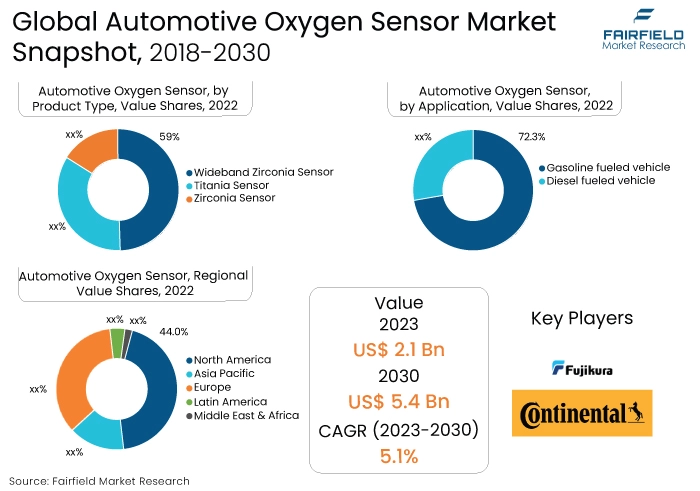
Quick Report Digest
- The proliferation of electric vehicles in the automotive industry is driving an upward trend in the demand for oxygen sensors, which highlights the criticality of such devices for monitoring battery efficiency and emissions.
- Adoption of sophisticated sensor technologies, such as microcontrollers and MEMS-based sensors, to improve performance and accuracy, in line with the industry's objective of reducing emissions and enhancing vehicle efficiency.
- The incorporation of oxygen sensors into intelligent automotive systems would enable the monitoring and analysis of data in real-time, thereby optimising vehicle performance and facilitating predictive maintenance.
- The increasing global focus on environmental regulations is propelling the need for oxygen sensors to ensure adherence to emission standards and mitigate automobiles' ecological impact.
- Wideband Zirconia Sensor is anticipated to have the largest market share among Zirconia Sensor, Wideband Zirconia Sensor, and Titania Sensor segments. This is attributed to its enhanced precision and wider operational range, which render it well-suited for contemporary engine management systems.
- The higher rate of global adoption of gasoline-powered vehicles is anticipated to result in their market share dominance, especially in regions where electric vehicle infrastructure is still being developed. Additionally, for optimal fuel economy, gasoline engines require more precise oxygen sensor feedback.
- According to projections, the OEM sector will maintain the largest market share as manufacturers progressively incorporate oxygen sensors as standard equipment in their vehicles to abide by regulatory standards and improve performance.
- North America is anticipated to have the highest market penetration as a result of its dense automotive manufacturing sector and strict emission regulations. Oxygen sensors are widely employed in automotive applications to guarantee engine efficiency and compliance with emission regulations.
- Asia Pacific is anticipated to have the most rapid market penetration growth because of the automotive industry's expansion, especially in countries such as China, and India. As environmental concerns and vehicle production increase, so does the demand for oxygen sensors for emission control and performance optimisation.
A Look Back and a Look Forward – Comparative Analysis
The global automotive oxygen sensor market is presently undergoing consistent expansion due to factors such as rising vehicle production, rigorous emission regulations, and technological advancements in sensor systems. The industry's dedication to sustainability is evident in the noticeable transition towards more advanced sensor systems for monitoring battery efficiency and emissions, which is a direct result of the increasing popularity of electric vehicles.
Furthermore, the incorporation of oxygen sensors into intelligent automotive systems to analyse data in real-time is bolstering the performance of vehicles and propelling the expansion of the market.
Over the years, the market has experienced substantial expansion, which has coincided with the development of automotive technology. Since the initial implementation of rudimentary oxygen sensors to the advancement of sophisticated MEMS-based sensors, the automotive industry has witnessed a consistent evolution of the market in response to shifting demands.
Anticipated market expansion persists as automakers allocate resources towards research and development to abide by more stringent emission regulations and satisfy consumer preferences for fuel-efficient and ecologically sustainable automobiles.
Additionally, it is expected that the expanding use of autonomous driving technology and the rising prevalence of electric vehicles will contribute to the increased demand for oxygen sensors, creating profitable prospects for market participants.
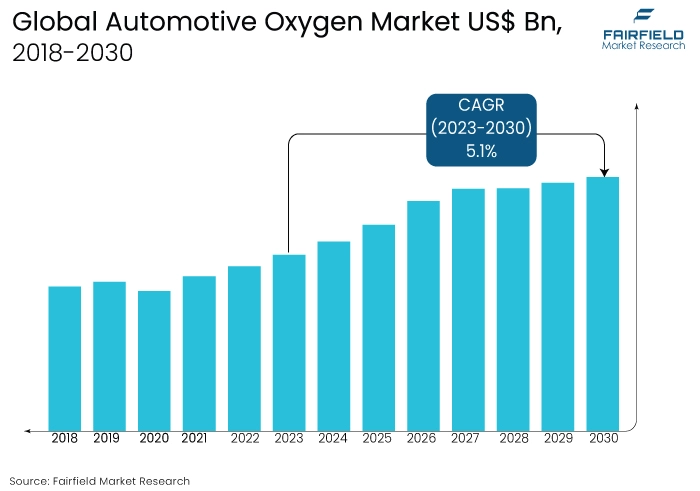
Key Growth Determinants
- Stringent Emission Regulations
Governments across the globe have implemented rigorous emission regulations, which are a major factor propelling the expansion of the automotive oxygen sensor market. The reduction of detrimental pollutants released by vehicles is a requirement of these regulations, which forces manufacturers to incorporate sophisticated emission control systems.
By providing feedback to the engine control unit regarding optimal fuel combustion and precisely measuring the oxygen levels in exhaust gases, oxygen sensors are vital to ensuring compliance with these regulations. The escalating stringency of emission standards has resulted in a sustained surge in the need for oxygen sensors, which in turn has stimulated advancements in sensor technology and generated prospects for market growth.
- Increasing Vehicle Production
The ongoing expansion of worldwide vehicle manufacturing serves as a significant catalyst for the increasing need for automotive oxygen sensors. The increasing expansion of the automotive industry to cater to the expanding needs of consumers, especially in emerging markets, underscores the criticality of implementing efficient emission control systems.
Modern vehicles are devoid of oxygen sensors, which are critical for modulating and monitoring the composition of exhaust gas to comply with emission standards. As manufacturers endeavour to improve fuel efficiency, decrease emissions, and adhere to regulatory standards, it is anticipated that the production of vehicles will increase, thereby propelling the demand for oxygen sensors and fostering market expansion.
- Technological Advancements in Sensor Technology
Considerable expansion is being propelled by technological advances in sensor technology within the automotive oxygen sensor sector. Oxygen sensor capabilities have been transformed by developments including microcontrollers, wideband sensor technology, MEMS-based sensors, quicker response times, and broader operating ranges. These developments address the dynamic requirements of the automotive sector, where accuracy and dependability are critical.
Moreover, their value proposition is further enhanced through the incorporation of oxygen sensors into intelligent automotive systems, which enables real-time data analysis and predictive maintenance. The ongoing progress in sensor technology is anticipated to lead to enhanced vehicle performance and emissions control, thereby increasing the demand for automotive oxygen sensors and subsequently stimulating market expansion.
Major Growth Barriers
- High Cost of Advanced Sensor Technology
The substantial investment required for sophisticated sensor technology is a substantial impediment to the growth of the automotive oxygen sensor market. Despite the performance improvements brought about by innovations such as wideband technology and MEMS-based sensors, their substantial production costs continue to impede their widespread adoption, especially within the automotive industry's cost-conscious sectors.
- Dependency on Automotive Industry’s Growth
The automotive industry's expansion and stability are critical determinants of the automotive oxygen sensor market. The vehicle production rates can be substantially influenced by economic downturns, variations in consumer demand, and disruptions in supply chains; consequently, these factors can have an impact on the demand for oxygen sensors. Volatility and uncertainty are introduced into the market due to this dependence, which impedes consistent growth.
Key Trends and Opportunities to Look at
- A Rapid Shift Toward Electric Vehicles
Environmental concerns and government incentives are propelling a substantial transition in the automotive sector towards electric vehicles (EVs). The adoption of this trend is accelerating internationally, with Europe and Asia-Pacific taking the lead. Tesla, Volkswagen, and BMW, among others, are making substantial investments in EV technology.
Brands will probably capitalise on this trend by augmenting their electric vehicle (EV) portfolios, allocating resources towards charging infrastructure, and improving battery efficiency to satisfy the increasing consumer desire for environmentally friendly modes of transportation.
- Integration of ADAS
A growing number of vehicles are incorporating Advanced Driver Assistance Systems (ADAS), which improve both the safety and driving experience of passengers. Although this trend is expanding in all regions, Europe and North America have the highest rates of adoption.
Bosch, Continental, and Aptiv are among the leading organisations in the development of ADAS. By integrating ADAS features into their vehicles, brands are capitalising on this trend, bolstering their reputation for safety, and appealing to technologically inclined consumers in search of advanced driving assistance.
- Emphasis on Connectivity, and In-Car Technology
An increasing focus is being placed on connectivity and technological advancements within automobiles, as customers expect the smooth integration of smartphones and sophisticated infotainment systems. Major markets for this trend are Asia Pacific, and North America where it is prevalent worldwide.
Automobile manufacturers are collaborating with tech giants, including Apple, Google, and Samsung, to integrate their technologies. Prominent smartphone platforms will likely be integrated into brand-owned infotainment systems, which are designed to be user-friendly to improve the driving experience and appeal to technologically inclined customers.
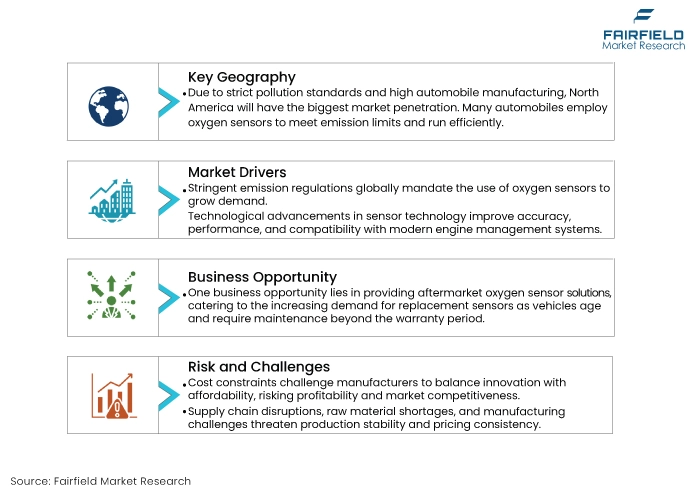
How Does the Regulatory Scenario Shape this Industry?
Regulatory frameworks are of paramount importance in the automotive industry as they exert significant influence over market dynamics and technological advancements. As an illustration, the Environmental Protection Agency (EPA) enforces emission regulations specified in the Clean Air Act, which strictly prohibits the discharge of detrimental pollutants from motor vehicles within the US.
Likewise, to comply with the Euro standards, which establish emission thresholds for automobiles sold within member states, the European Union promotes the implementation of greener technologies like oxygen sensors.
Additionally, the implementation of region-specific regulations, such as the emission regulations for vehicles in China, has incentivised automobile manufacturers to allocate resources towards the development of emission control technologies, such as oxygen sensors. Automotive oxygen sensor innovation and market demand are propelled by these regulatory frameworks, which mandate adherence to rigorous emission standards.
Fairfield’s Ranking Board
Top Segments
- Wideband Zirconia Sensor Prime Category
The Wideband Zirconia Sensor will probably hold the most substantial portion. In contrast to conventional zirconia and titania sensors, wideband zirconia sensors provide enhanced precision and an expanded operational spectrum, rendering them exceptionally well-suited for contemporary engine management systems.
The capacity to accurately quantify oxygen concentrations in exhaust gases is highly esteemed in contexts that necessitate sophisticated emission regulation and fuel economy enhancement.
Regarding growth rate, it is anticipated that the Titania Sensor segment will expand at the most rapid pace. This is predominantly attributable to the rising demand for inexpensive sensor solutions, particularly in price-sensitive emergent markets.
While titanium sensors may not be as precise as their zirconia counterparts, they provide a cost-effective substitute for fundamental emission control needs. This has led to their widespread implementation in various vehicles, and applications.
- Gasoline-Powered Vehicles Command a Dominant Market Share
It is anticipated that the gasoline-powered vehicle segment will hold the most substantial market share. Throughout history, gasoline-powered vehicles have held a dominant position in the automotive industry, especially in regions such as North America and Europe. This preference can be attributed to their comparatively reduced initial investment, superior driving experience, and more readily available refuelling infrastructure.
The diesel-powered vehicle segment is projected to experience a moderately accelerated growth rate. Notwithstanding the obstacles posed by more stringent emission regulations and adverse public sentiment concerning emissions and ecological repercussions, diesel vehicles continue to provide benefits in terms of torque and fuel efficiency, particularly in industrial settings encompassing heavy-duty trucks and specific SUV models.
Furthermore, it is anticipated that developments in diesel engine technology, including enhanced emissions control systems and cleaner-burning engines, will contribute to the expansion of the segment within specific market niches.
- OEMs Contribute the Maximum Share
The market share of the OEM segment is anticipated to be the largest among the segments mentioned. As oxygen sensors are integrated into the initial vehicle assembly process, OEMs serve as the principal suppliers for sensor procurement.
Moreover, OEMs frequently maintain longstanding partnerships with automakers and strictly adhere to rigorous quality criteria, which serves to reinforce their position of authority in the market.
It is anticipated that the IAS (Independent Automotive Supplier) segment will experience the most rapid development in terms of growth rate. Independent automotive suppliers provide aftermarket oxygen sensors to accommodate the needs of vehicle owners who need replacements or modifications post-warranty.
As vehicles age and require maintenance, it is anticipated that the demand for aftermarket sensors will increase, especially in regions with a high concentration of older vehicles or where do-it-yourself repairs are prevalent. Moreover, IASs frequently produce innovative, cost-effective alternatives that appeal to customers in search of performance and value.
Regional Frontrunners
North America Accounts for the Largest Market Share
North America is anticipated to account for the largest market proportion of the worldwide automotive oxygen sensor industry. This geographical area comprises prominent centres for automotive production, including the US, and Canada.
The expanding automotive industry, accelerated urbanisation, and rising levels of disposable income propel the demand for vehicles equipped with oxygen sensors. This is done to comply with emission regulations and improve fuel efficiency.
Furthermore, government initiatives promoting the adoption of electric vehicles and stringent emission limits propel the market growth in North America, solidifying its position as a key contributor to the global market share.
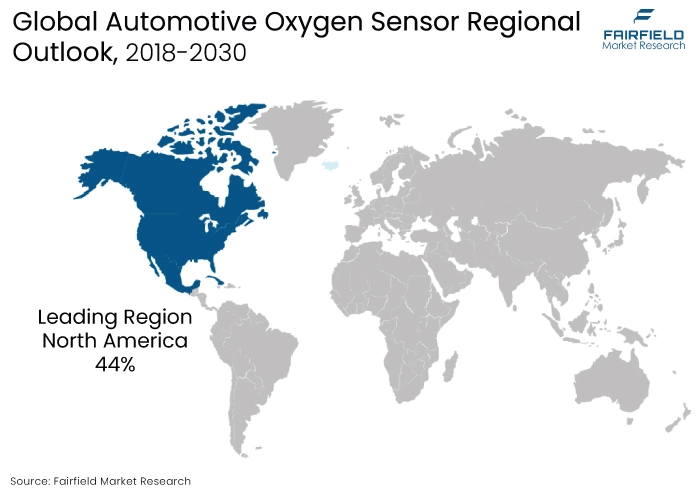
Latin America Emerges Highly Lucrative with Ample Opportunity
Latin America is anticipated to witness the most rapid expansion of the worldwide automotive oxygen sensor market. Despite political instability and economic difficulties in some nations, the automotive industry in Latin America is expanding steadily due to increasing consumer demand and infrastructure development.
Regional initiatives to reduce emissions and conform to global benchmarks serve as catalysts for the implementation of oxygen sensors in automobiles. With the pursuit of environmental compliance and the modernisation of automotive fleets, Latin American nations can anticipate a significant increase in demand for oxygen sensors, which will propel the region's growth to unprecedented levels.
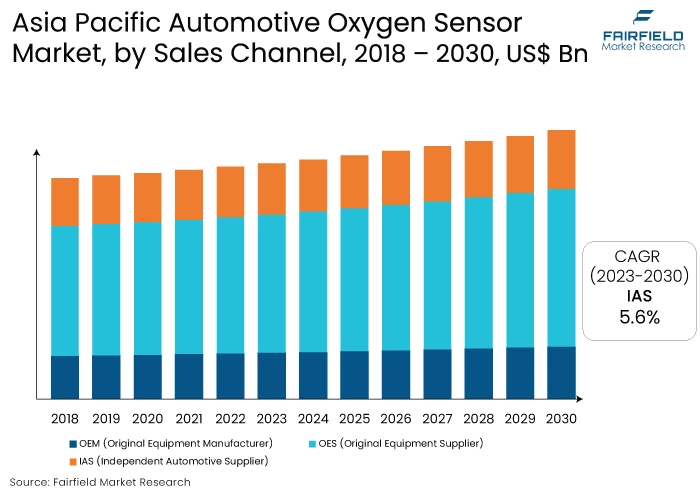
Fairfield’s Competitive Landscape Analysis
Significant trends that propel competition within the competitive environment comprise technological innovation, product differentiation, and strategic partnerships.
Enterprises are making substantial investments in research and development to improve the performance and dependability of their sensors, all the while forming strategic partnerships with automotive manufacturers to ensure enduring contracts and market presence.
Furthermore, the incorporation of sensor technology into intelligent automotive systems and the rise of aftermarket solutions are transforming the competitive environment, presenting prospects for both incumbent firms and emerging participants.
Who are the Leaders in the Global Automotive Oxygen Sensor Space?
- Fujikura Ltd.
- Bosch Auto Parts
- NGK SPARK PLUG CO., LTD.
- Pricol Limited
- RAE
- Continental AG
- Hella KGaA Hueck & Co.
- SJ AUTOMOTIVE CO. LTD.
- Federal-Mogul
- DENSO EUROPE
Significant Industry Developments
New Product Launch
- Sept 2021: DENSO Products and Services Americas is expanding its comprehensive array of First Time Fit oxygen sensors by 65 part numbers. DENSO, which continues to be the market leader with its high-quality oxygen sensors that are installed in 99 percent of vehicles manufactured in the U.S., Europe, and Asia, will increase its product line to 1,362 part numbers by the end of September and deliver an additional 38 units by mid-2022.
An Expert’s Eye
Demand and Future Growth
Several foreseeable future factors are anticipated to sustain the long-term growth of the automotive oxygen sensor market. To begin with, the increasing prevalence of internal combustion engine vehicles and the worldwide emphasis on environmental sustainability and compliance with more stringent emission regulations will maintain the demand for oxygen sensors.
This is particularly true in the light of the rising adoption of electric vehicles. As manufacturers seek more precise and efficient solutions for engine optimisation and emission control, further developments in sensor technology, including wideband and MEMS-based sensors, will stimulate market expansion.
Supply Side of the Market
The automotive oxygen sensor market demonstrates dynamic demand-supply dynamics on the supply side. Oxygen sensor demand is anticipated to remain robust due to the proliferation of emission control technologies and the expansion of vehicle production.
Nevertheless, manufacturing difficulties, disruptions in the supply chain, and shortages of basic materials may all affect sensor accessibility, resulting in scarcities and fluctuations in prices.
The global Automotive Oxygen Sensor Market is Segmented as Below:
By Product Type:
- Zirconia Sensor
- Wideband Zirconia Sensor
- Titania Sensor
By Application:
- Gasoline fueled vehicle
- Diesel-fueled vehicle
By Sales Channel:
- OEM (Original Equipment Manufacturer)
- OES (Original Equipment Supplier)
- IAS (Independent Automotive Supplier)
By Geographic Coverage:
- North America
- U.S.
- Canada
- Europe
- Germany
- U.K.
- France
- Italy
- Turkey
- Russia
- Rest of Europe
- Asia Pacific
- China
- Japan
- South Korea
- India
- Southeast Asia
- Rest of Asia Pacific
- Latin America
- Brazil
- Mexico
- Argentina
- Rest of Latin America
- Middle East & Africa
- GCC
- South Africa
- Egypt
- Nigeria
- Rest of the Middle East & Africa
1. Executive Summary
1.1. Global Automotive Oxygen Sensor Market Snapshot
1.2. Future Projections
1.3. Key Market Trends
1.4. Regional Snapshot, by Value, 2022
1.5. Analyst Recommendations
2. Market Overview
2.1. Market Definitions and Segmentations
2.2. Market Dynamics
2.2.1. Drivers
2.2.2. Restraints
2.2.3. Market Opportunities
2.3. Value Chain Analysis
2.4. Porter’s Five Forces Analysis
2.5. Covid-19 Impact Analysis
2.5.1. Supply
2.5.2. Demand
2.6. Impact of Ukraine-Russia Conflict
2.7. Economic Overview
2.7.1. World Economic Projections
2.8. PESTLE Analysis
3. Global Automotive Oxygen Sensor Market Outlook, 2018 - 2030
3.1. Global Automotive Oxygen Sensor Market Outlook, by Product Type, Value (US$ Mn), 2018 - 2030
3.1.1. Key Highlights
3.1.1.1. Zirconia Sensor
3.1.1.2. Wideband Zirconia Sensor
3.1.1.3. Titania Sensor
3.2. Global Automotive Oxygen Sensor Market Outlook, by Sales Channel, Value (US$ Mn), 2018 - 2030
3.2.1. Key Highlights
3.2.1.1. OEM (Original Equipment Manufacturer)
3.2.1.2. OES (Original Equipment Supplier)
3.2.1.3. IAS (Independent Automotive Supplier)
3.3. Global Automotive Oxygen Sensor Market Outlook, by Application, Value (US$ Mn), 2018 - 2030
3.3.1. Key Highlights
3.3.1.1. Gasoline fueled vehicle
3.3.1.2. Diesel fueled vehicle
3.4. Global Automotive Oxygen Sensor Market Outlook, by Region, Value (US$ Mn), 2018 - 2030
3.4.1. Key Highlights
3.4.1.1. North America
3.4.1.2. Europe
3.4.1.3. Asia Pacific
3.4.1.4. Latin America
3.4.1.5. Middle East & Africa
4. North America Automotive Oxygen Sensor Market Outlook, 2018 - 2030
4.1. North America Automotive Oxygen Sensor Market Outlook, by Product Type, Value (US$ Mn), 2018 - 2030
4.1.1. Key Highlights
4.1.1.1. Zirconia Sensor
4.1.1.2. Wideband Zirconia Sensor
4.1.1.3. Titania Sensor
4.2. North America Automotive Oxygen Sensor Market Outlook, by Sales Channel, Value (US$ Mn), 2018 - 2030
4.2.1. Key Highlights
4.2.1.1. OEM (Original Equipment Manufacturer)
4.2.1.2. OES (Original Equipment Supplier)
4.2.1.3. IAS (Independent Automotive Supplier)
4.3. North America Automotive Oxygen Sensor Market Outlook, by Application, Value (US$ Mn), 2018 - 2030
4.3.1. Key Highlights
4.3.1.1. Gasoline fueled vehicle
4.3.1.2. Diesel fueled vehicle
4.3.2. BPS Analysis/Market Attractiveness Analysis
4.4. North America Automotive Oxygen Sensor Market Outlook, by Country, Value (US$ Mn), 2018 - 2030
4.4.1. Key Highlights
4.4.1.1. U.S. Automotive Oxygen Sensor Market by Product Type, Value (US$ Mn), 2018 - 2030
4.4.1.2. U.S. Automotive Oxygen Sensor Market Sales Channel, Value (US$ Mn), 2018 - 2030
4.4.1.3. U.S. Automotive Oxygen Sensor Market Application, Value (US$ Mn), 2018 - 2030
4.4.1.4. Canada Automotive Oxygen Sensor Market by Product Type, Value (US$ Mn), 2018 - 2030
4.4.1.5. Canada Automotive Oxygen Sensor Market Sales Channel, Value (US$ Mn), 2018 - 2030
4.4.1.6. Canada Automotive Oxygen Sensor Market Application, Value (US$ Mn), 2018 - 2030
4.4.2. BPS Analysis/Market Attractiveness Analysis
5. Europe Automotive Oxygen Sensor Market Outlook, 2018 - 2030
5.1. Europe Automotive Oxygen Sensor Market Outlook, by Product Type, Value (US$ Mn), 2018 - 2030
5.1.1. Key Highlights
5.1.1.1. Zirconia Sensor
5.1.1.2. Wideband Zirconia Sensor
5.1.1.3. Titania Sensor
5.2. Europe Automotive Oxygen Sensor Market Outlook, by Sales Channel, Value (US$ Mn), 2018 - 2030
5.2.1. Key Highlights
5.2.1.1. OEM (Original Equipment Manufacturer)
5.2.1.2. OES (Original Equipment Supplier)
5.2.1.3. IAS (Independent Automotive Supplier)
5.3. Europe Automotive Oxygen Sensor Market Outlook, by Application, Value (US$ Mn), 2018 - 2030
5.3.1. Key Highlights
5.3.1.1. Gasoline fueled vehicle
5.3.1.2. Diesel fueled vehicle
5.3.2. BPS Analysis/Market Attractiveness Analysis
5.4. Europe Automotive Oxygen Sensor Market Outlook, by Country, Value (US$ Mn), 2018 - 2030
5.4.1. Key Highlights
5.4.1.1. Germany Automotive Oxygen Sensor Market by Product Type, Value (US$ Mn), 2018 - 2030
5.4.1.2. Germany Automotive Oxygen Sensor Market Sales Channel, Value (US$ Mn), 2018 - 2030
5.4.1.3. Germany Automotive Oxygen Sensor Market Application, Value (US$ Mn), 2018 - 2030
5.4.1.4. U.K. Automotive Oxygen Sensor Market by Product Type, Value (US$ Mn), 2018 - 2030
5.4.1.5. U.K. Automotive Oxygen Sensor Market Sales Channel, Value (US$ Mn), 2018 - 2030
5.4.1.6. U.K. Automotive Oxygen Sensor Market Application, Value (US$ Mn), 2018 - 2030
5.4.1.7. France Automotive Oxygen Sensor Market by Product Type, Value (US$ Mn), 2018 - 2030
5.4.1.8. France Automotive Oxygen Sensor Market Sales Channel, Value (US$ Mn), 2018 - 2030
5.4.1.9. France Automotive Oxygen Sensor Market Application, Value (US$ Mn), 2018 - 2030
5.4.1.10. Italy Automotive Oxygen Sensor Market by Product Type, Value (US$ Mn), 2018 - 2030
5.4.1.11. Italy Automotive Oxygen Sensor Market Sales Channel, Value (US$ Mn), 2018 - 2030
5.4.1.12. Italy Automotive Oxygen Sensor Market Application, Value (US$ Mn), 2018 - 2030
5.4.1.13. Turkey Automotive Oxygen Sensor Market by Product Type, Value (US$ Mn), 2018 - 2030
5.4.1.14. Turkey Automotive Oxygen Sensor Market Sales Channel, Value (US$ Mn), 2018 - 2030
5.4.1.15. Turkey Automotive Oxygen Sensor Market Application, Value (US$ Mn), 2018 - 2030
5.4.1.16. Russia Automotive Oxygen Sensor Market by Product Type, Value (US$ Mn), 2018 - 2030
5.4.1.17. Russia Automotive Oxygen Sensor Market Sales Channel, Value (US$ Mn), 2018 - 2030
5.4.1.18. Russia Automotive Oxygen Sensor Market Application, Value (US$ Mn), 2018 - 2030
5.4.1.19. Rest of Europe Automotive Oxygen Sensor Market by Product Type, Value (US$ Mn), 2018 - 2030
5.4.1.20. Rest of Europe Automotive Oxygen Sensor Market Sales Channel, Value (US$ Mn), 2018 - 2030
5.4.1.21. Rest of Europe Automotive Oxygen Sensor Market Application, Value (US$ Mn), 2018 - 2030
5.4.2. BPS Analysis/Market Attractiveness Analysis
6. Asia Pacific Automotive Oxygen Sensor Market Outlook, 2018 - 2030
6.1. Asia Pacific Automotive Oxygen Sensor Market Outlook, by Product Type, Value (US$ Mn), 2018 - 2030
6.1.1. Key Highlights
6.1.1.1. Zirconia Sensor
6.1.1.2. Wideband Zirconia Sensor
6.1.1.3. Titania Sensor
6.2. Asia Pacific Automotive Oxygen Sensor Market Outlook, by Sales Channel, Value (US$ Mn), 2018 - 2030
6.2.1. Key Highlights
6.2.1.1. OEM (Original Equipment Manufacturer)
6.2.1.2. OES (Original Equipment Supplier)
6.2.1.3. IAS (Independent Automotive Supplier)
6.3. Asia Pacific Automotive Oxygen Sensor Market Outlook, by Application, Value (US$ Mn), 2018 - 2030
6.3.1. Key Highlights
6.3.1.1. Gasoline fueled vehicle
6.3.1.2. Diesel fueled vehicle
6.3.2. BPS Analysis/Market Attractiveness Analysis
6.4. Asia Pacific Automotive Oxygen Sensor Market Outlook, by Country, Value (US$ Mn), 2018 - 2030
6.4.1. Key Highlights
6.4.1.1. China Automotive Oxygen Sensor Market by Product Type, Value (US$ Mn), 2018 - 2030
6.4.1.2. China Automotive Oxygen Sensor Market Sales Channel, Value (US$ Mn), 2018 - 2030
6.4.1.3. China Automotive Oxygen Sensor Market Application, Value (US$ Mn), 2018 - 2030
6.4.1.4. Japan Automotive Oxygen Sensor Market by Product Type, Value (US$ Mn), 2018 - 2030
6.4.1.5. Japan Automotive Oxygen Sensor Market Sales Channel, Value (US$ Mn), 2018 - 2030
6.4.1.6. Japan Automotive Oxygen Sensor Market Application, Value (US$ Mn), 2018 - 2030
6.4.1.7. South Korea Automotive Oxygen Sensor Market by Product Type, Value (US$ Mn), 2018 - 2030
6.4.1.8. South Korea Automotive Oxygen Sensor Market Sales Channel, Value (US$ Mn), 2018 - 2030
6.4.1.9. South Korea Automotive Oxygen Sensor Market Application, Value (US$ Mn), 2018 - 2030
6.4.1.10. India Automotive Oxygen Sensor Market by Product Type, Value (US$ Mn), 2018 - 2030
6.4.1.11. India Automotive Oxygen Sensor Market Sales Channel, Value (US$ Mn), 2018 - 2030
6.4.1.12. India Automotive Oxygen Sensor Market Application, Value (US$ Mn), 2018 - 2030
6.4.1.13. Southeast Asia Automotive Oxygen Sensor Market by Product Type, Value (US$ Mn), 2018 - 2030
6.4.1.14. Southeast Asia Automotive Oxygen Sensor Market Sales Channel, Value (US$ Mn), 2018 - 2030
6.4.1.15. Southeast Asia Automotive Oxygen Sensor Market Application, Value (US$ Mn), 2018 - 2030
6.4.1.16. Rest of Asia Pacific Automotive Oxygen Sensor Market by Product Type, Value (US$ Mn), 2018 - 2030
6.4.1.17. Rest of Asia Pacific Automotive Oxygen Sensor Market Sales Channel, Value (US$ Mn), 2018 - 2030
6.4.1.18. Rest of Asia Pacific Automotive Oxygen Sensor Market Application, Value (US$ Mn), 2018 - 2030
6.4.2. BPS Analysis/Market Attractiveness Analysis
7. Latin America Automotive Oxygen Sensor Market Outlook, 2018 - 2030
7.1. Latin America Automotive Oxygen Sensor Market Outlook, by Product Type, Value (US$ Mn), 2018 - 2030
7.1.1. Key Highlights
7.1.1.1. Zirconia Sensor
7.1.1.2. Wideband Zirconia Sensor
7.1.1.3. Titania Sensor
7.2. Latin America Automotive Oxygen Sensor Market Outlook, by Sales Channel, Value (US$ Mn), 2018 - 2030
7.2.1. Key Highlights
7.2.1.1. OEM (Original Equipment Manufacturer)
7.2.1.2. OES (Original Equipment Supplier)
7.2.1.3. IAS (Independent Automotive Supplier)
7.3. Latin America Automotive Oxygen Sensor Market Outlook, by Application, Value (US$ Mn), 2018 - 2030
7.3.1. Key Highlights
7.3.1.1. Gasoline fueled vehicle
7.3.1.2. Diesel fueled vehicle
7.3.2. BPS Analysis/Market Attractiveness Analysis
7.4. Latin America Automotive Oxygen Sensor Market Outlook, by Country, Value (US$ Mn), 2018 - 2030
7.4.1. Key Highlights
7.4.1.1. Brazil Automotive Oxygen Sensor Market by Product Type, Value (US$ Mn), 2018 - 2030
7.4.1.2. Brazil Automotive Oxygen Sensor Market Sales Channel, Value (US$ Mn), 2018 - 2030
7.4.1.3. Brazil Automotive Oxygen Sensor Market Application, Value (US$ Mn), 2018 - 2030
7.4.1.4. Mexico Automotive Oxygen Sensor Market by Product Type, Value (US$ Mn), 2018 - 2030
7.4.1.5. Mexico Automotive Oxygen Sensor Market Sales Channel, Value (US$ Mn), 2018 - 2030
7.4.1.6. Mexico Automotive Oxygen Sensor Market Application, Value (US$ Mn), 2018 - 2030
7.4.1.7. Argentina Automotive Oxygen Sensor Market by Product Type, Value (US$ Mn), 2018 - 2030
7.4.1.8. Argentina Automotive Oxygen Sensor Market Sales Channel, Value (US$ Mn), 2018 - 2030
7.4.1.9. Argentina Automotive Oxygen Sensor Market Application, Value (US$ Mn), 2018 - 2030
7.4.1.10. Rest of Latin America Automotive Oxygen Sensor Market by Product Type, Value (US$ Mn), 2018 - 2030
7.4.1.11. Rest of Latin America Automotive Oxygen Sensor Market Sales Channel, Value (US$ Mn), 2018 - 2030
7.4.1.12. Rest of Latin America Automotive Oxygen Sensor Market Application, Value (US$ Mn), 2018 - 2030
7.4.2. BPS Analysis/Market Attractiveness Analysis
8. Middle East & Africa Automotive Oxygen Sensor Market Outlook, 2018 - 2030
8.1. Middle East & Africa Automotive Oxygen Sensor Market Outlook, by Product Type, Value (US$ Mn), 2018 - 2030
8.1.1. Key Highlights
8.1.1.1. Zirconia Sensor
8.1.1.2. Wideband Zirconia Sensor
8.1.1.3. Titania Sensor
8.2. Middle East & Africa Automotive Oxygen Sensor Market Outlook, by Sales Channel, Value (US$ Mn), 2018 - 2030
8.2.1. Key Highlights
8.2.1.1. OEM (Original Equipment Manufacturer)
8.2.1.2. OES (Original Equipment Supplier)
8.2.1.3. IAS (Independent Automotive Supplier)
8.3. Middle East & Africa Automotive Oxygen Sensor Market Outlook, by Application, Value (US$ Mn), 2018 - 2030
8.3.1. Key Highlights
8.3.1.1. Gasoline fueled vehicle
8.3.1.2. Diesel fueled vehicle
8.4. Middle East & Africa Automotive Oxygen Sensor Market Outlook, by Country, Value (US$ Mn), 2018 - 2030
8.4.1. Key Highlights
8.4.1.1. GCC Automotive Oxygen Sensor Market by Product Type, Value (US$ Mn), 2018 - 2030
8.4.1.2. GCC Automotive Oxygen Sensor Market Sales Channel, Value (US$ Mn), 2018 - 2030
8.4.1.3. GCC Automotive Oxygen Sensor Market Application, Value (US$ Mn), 2018 - 2030
8.4.1.4. South Africa Automotive Oxygen Sensor Market by Product Type, Value (US$ Mn), 2018 - 2030
8.4.1.5. South Africa Automotive Oxygen Sensor Market Sales Channel, Value (US$ Mn), 2018 - 2030
8.4.1.6. South Africa Automotive Oxygen Sensor Market Application, Value (US$ Mn), 2018 - 2030
8.4.1.7. Egypt Automotive Oxygen Sensor Market by Product Type, Value (US$ Mn), 2018 - 2030
8.4.1.8. Egypt Automotive Oxygen Sensor Market Sales Channel, Value (US$ Mn), 2018 - 2030
8.4.1.9. Egypt Automotive Oxygen Sensor Market Application, Value (US$ Mn), 2018 - 2030
8.4.1.10. Nigeria Automotive Oxygen Sensor Market by Product Type, Value (US$ Mn), 2018 - 2030
8.4.1.11. Nigeria Automotive Oxygen Sensor Market Sales Channel, Value (US$ Mn), 2018 - 2030
8.4.1.12. Nigeria Automotive Oxygen Sensor Market Application, Value (US$ Mn), 2018 - 2030
8.4.1.13. Rest of Middle East & Africa Automotive Oxygen Sensor Market by Product Type, Value (US$ Mn), 2018 - 2030
8.4.1.14. Rest of Middle East & Africa Automotive Oxygen Sensor Market Sales Channel, Value (US$ Mn), 2018 - 2030
8.4.1.15. Rest of Middle East & Africa Automotive Oxygen Sensor Market Application, Value (US$ Mn), 2018 - 2030
8.4.2. BPS Analysis/Market Attractiveness Analysis
9. Competitive Landscape
9.1. Application vs Sales Channel Heatmap
9.2. Manufacturer vs Sales Channel Heatmap
9.3. Company Market Share Analysis, 2022
9.4. Competitive Dashboard
9.5. Company Profiles
9.5.1. Fujikura Ltd.
9.5.1.1. Company Overview
9.5.1.2. Product Type Portfolio
9.5.1.3. Financial Overview
9.5.1.4. Business Strategies and Development
9.5.2. Bosch Auto Parts
9.5.2.1. Company Overview
9.5.2.2. Product Type Portfolio
9.5.2.3. Financial Overview
9.5.2.4. Business Strategies and Development
9.5.3. NGK SPARK PLUG CO., LTD.
9.5.3.1. Company Overview
9.5.3.2. Product Type Portfolio
9.5.3.3. Financial Overview
9.5.3.4. Business Strategies and Development
9.5.4. Pricol Limited
9.5.4.1. Company Overview
9.5.4.2. Product Type Portfolio
9.5.4.3. Financial Overview
9.5.4.4. Business Strategies and Development
9.5.5. RAE
9.5.5.1. Company Overview
9.5.5.2. Product Type Portfolio
9.5.5.3. Financial Overview
9.5.5.4. Business Strategies and Development
9.5.6. Continental AG
9.5.6.1. Company Overview
9.5.6.2. Product Type Portfolio
9.5.6.3. Financial Overview
9.5.6.4. Business Strategies and Development
9.5.7. Hella KGaA Hueck & Co.
9.5.7.1. Company Overview
9.5.7.2. Product Type Portfolio
9.5.7.3. Financial Overview
9.5.7.4. Business Strategies and Development
9.5.8. SJ AUTOMOTIVE CO. LTD.
9.5.8.1. Company Overview
9.5.8.2. Product Type Portfolio
9.5.8.3. Financial Overview
9.5.8.4. Business Strategies and Development
9.5.9. Federal-Mogul
9.5.9.1. Company Overview
9.5.9.2. Product Type Portfolio
9.5.9.3. Financial Overview
9.5.9.4. Business Strategies and Development
9.5.10. DENSO EUROPE
9.5.10.1. Company Overview
9.5.10.2. Product Type Portfolio
9.5.10.3. Financial Overview
9.5.10.4. Business Strategies and Development
10. Appendix
10.1. Research Methodology
10.2. Report Assumptions
10.3. Acronyms and Abbreviations
|
BASE YEAR |
HISTORICAL DATA |
FORECAST PERIOD |
UNITS |
|||
|
2022 |
|
2018 - 2022 |
2023 - 2030 |
Value: US$ Million |
||
|
REPORT FEATURES |
DETAILS |
|
Product Type Coverage |
|
|
Application Coverage |
|
|
Sales Channel Coverage |
|
|
Geographical Coverage |
|
|
Leading Companies |
|
|
Report Highlights |
Key Market Indicators, Macro-micro economic impact analysis, Technological Roadmap, Key Trends, Driver, Restraints, and Future Opportunities & Revenue Pockets, Porter’s 5 Forces Analysis, Historical Trend (2019-2021), Market Estimates and Forecast, Market Dynamics, Industry Trends, Competition Landscape, Category, Region, Country-wise Trends & Analysis, COVID-19 Impact Analysis (Demand and Supply Chain) |
